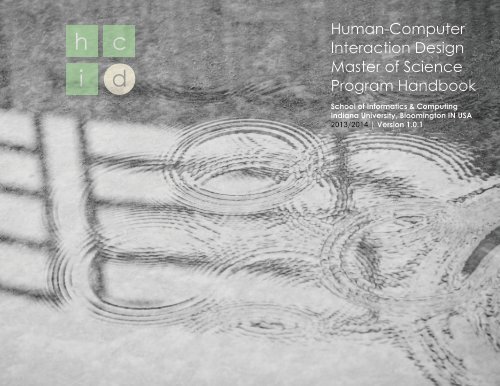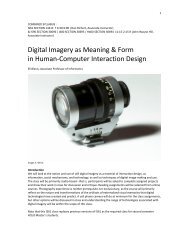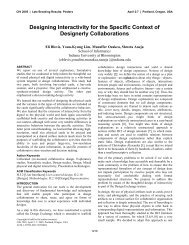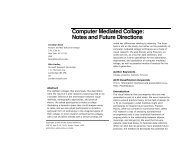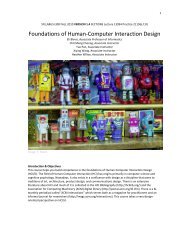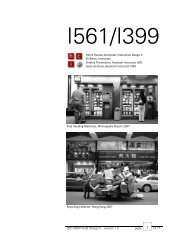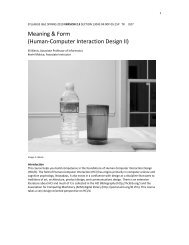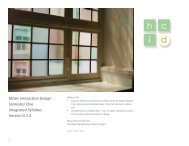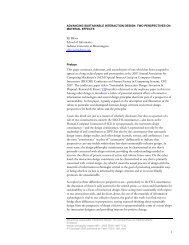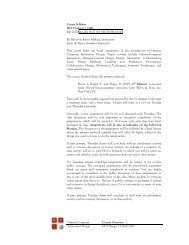Human-Computer Interaction Design Master of Science Program ...
Human-Computer Interaction Design Master of Science Program ...
Human-Computer Interaction Design Master of Science Program ...
Create successful ePaper yourself
Turn your PDF publications into a flip-book with our unique Google optimized e-Paper software.
h c<br />
i d<br />
<strong>Human</strong>-<strong>Computer</strong><br />
<strong>Interaction</strong> <strong>Design</strong><br />
<strong>Master</strong> <strong>of</strong> <strong>Science</strong><br />
<strong>Program</strong> Handbook<br />
School <strong>of</strong> Informatics & Computing<br />
Indiana University, Bloomington IN USA<br />
2013/2014 | Version 1.0.1<br />
1
2 3
Contents<br />
1. Introduction<br />
2. HCI/d MS <strong>Program</strong> Structure<br />
3. Course Descriptions<br />
4. For Reference<br />
Kindly note that this handbook has been revised very<br />
extensively, this year—with so many changes, it should be<br />
considered as somewhat <strong>of</strong> a draft copy. Please allow for<br />
changes and additions to follow. Kindly direct questions<br />
about this document to Eli Blevis—eblevis@indiana.edu<br />
Unless otherwise indicated, images in this handbook are by<br />
Eli Blevis.<br />
1. Introduction<br />
This handbook details the <strong>Master</strong> <strong>of</strong> <strong>Science</strong> (MS)<br />
program in <strong>Human</strong>-<strong>Computer</strong> <strong>Interaction</strong> <strong>Design</strong><br />
(HCI/d) at the School <strong>of</strong> Informatics & Computing,<br />
Indiana University, Bloomington, Indiana USA.<br />
The Core HCI/d Faculty are:<br />
Jeff Bardzell<br />
Associate Pr<strong>of</strong>essor <strong>of</strong> Informatics<br />
Shaowen Bardzell<br />
Associate Pr<strong>of</strong>essor <strong>of</strong> Informatics<br />
Eli Blevis<br />
Associate Pr<strong>of</strong>essor <strong>of</strong> Informatics,<br />
Director <strong>of</strong> the HCI/d <strong>Program</strong><br />
Marty Siegel<br />
Pr<strong>of</strong>essor <strong>of</strong> Informatics,<br />
Director <strong>of</strong> Graduate <strong>Program</strong>s for Informatics<br />
Erik Stolterman<br />
Pr<strong>of</strong>essor <strong>of</strong> Informatics,<br />
Division Chair for Informatics<br />
Norman Su<br />
Assistant Pr<strong>of</strong>essor <strong>of</strong> Informatics<br />
The Staff associated with this program are:<br />
Linda Hostetter, Graduate Recorder<br />
Cheryl Engel, Admissions Assistant<br />
Kate Caldwell, Director <strong>of</strong> Career Services<br />
Kindly refer to www.soic.indiana.edu for contact and<br />
other details <strong>of</strong> these faculty and staff.<br />
The Director <strong>of</strong> the HCI/d program—Pr<strong>of</strong>. Eli Blevis—<br />
has the overall responsibility for the program, courses,<br />
and everything else that relates to the program. You<br />
may write to him about the program and once you<br />
are enrolled, you may contact him as well with any<br />
personal issues, concerns, or ideas you may have<br />
affecting your studies or the program or your wellbeing<br />
in general.<br />
The Graduate Director <strong>of</strong> the Informatics MS and<br />
PhD program—Pr<strong>of</strong>. Marty Siegel—is involved in more<br />
overall issues <strong>of</strong> being a graduate student in our<br />
school. You may also contact him with any issues or<br />
concerns, or just to chat. Marty is very friendly and<br />
approachable, with a great reputation for helping<br />
students.<br />
The collective goal <strong>of</strong> the core HCI/d faculty is to<br />
help you succeed in our program as an individual,<br />
while also ensuring that high standards are met as<br />
a collective investment in reputation by all faculty,<br />
students, and alumni who are connected to our program.<br />
Our goal is to be the best design-oriented HCI<br />
program in the world, and each <strong>of</strong> us participates in<br />
this vision.<br />
2. HCI/d MS <strong>Program</strong> Structure<br />
Schedule <strong>of</strong> Classes<br />
The <strong>Master</strong> <strong>of</strong> <strong>Science</strong> Degree <strong>Program</strong> in HCI/d<br />
consists <strong>of</strong> 36 credit hours <strong>of</strong> studies, normally taken<br />
over two consecutive years, evenly distributed as 3<br />
classes or 9 credit hours per semester.<br />
The schedules on the following pages show the<br />
classes you will take. There is some choice available<br />
in the second year <strong>of</strong> study in the form <strong>of</strong> electives.<br />
Since this is a two year program, the schedule shows<br />
classes in whole or in part for several different cohorts,<br />
for example:<br />
The Class <strong>of</strong> 2014<br />
Year 1 Fall 2013<br />
Year 1 Spring 2014<br />
Year 2 Fall 2013<br />
Year 2 Spring 2014<br />
The Class <strong>of</strong> 2015<br />
Year 1 Fall 2014<br />
Year 1 Spring 2015<br />
Year 2 Fall 2014<br />
Year 2 Spring 2015<br />
...<br />
and so forth<br />
Kindly read these schedules keeping your respective<br />
cohort in mind.<br />
4 5
How to Apply<br />
We are accepting applications for Fall 2014.<br />
Fall 2014 Priority Deadlines for<br />
Admission and Financial Aid:<br />
• International students: December 1, 2013<br />
• Domestic students: January 15, 2014<br />
For information about our graduate programs, go to<br />
http://www.soic.indiana.edu/graduate/index.shtml<br />
For information about how to apply to Indiana Uni-<br />
versity’s School <strong>of</strong> Informatics and Computing, go to<br />
http://www.soic.indiana.edu/prospective/grad-admit/apply/index.shtml.<br />
Special Instructions for HCI/d MS<br />
Students Application Portfolios<br />
HCI/d <strong>Program</strong> [Optional] Portfolio<br />
Purpose:<br />
A portfolio <strong>of</strong> your prior work will greatly help distinguish<br />
your application for the HCI/d program.<br />
Portfolios do not necessarily need to include only HCI<br />
or design work samples--they may include any sort<br />
<strong>of</strong> samples <strong>of</strong> your prior work as described below.<br />
We accept many students from a wide variety <strong>of</strong><br />
disciplines and backgrounds based on the quality<br />
<strong>of</strong> prior work, rather than the specific focus or area.<br />
Many excellent students begin the program without<br />
a background in HCI or design, and many excellent<br />
students do have prior HCI or design experience. A<br />
portfolio is optional, but highly recommended.<br />
Themes:<br />
The primary reason we accept students from a variety<br />
<strong>of</strong> different backgrounds is that our program is organized<br />
into three career-path themes, as described<br />
in the handbook, namely (i) interaction design, (ii)<br />
design strategies, and (iii) research, scholarship, &<br />
creative activity. Different backgrounds predict success<br />
in one area or another <strong>of</strong> these three careerpath<br />
themes. It is perfectly fine if you are not sure<br />
which <strong>of</strong> these three themes corresponds to your<br />
career goals before you start the program--however,<br />
the types <strong>of</strong> things you include in your portfolio may<br />
indicate a trajectory in one <strong>of</strong> these three themes or<br />
another, and we do hope to achieve a balanced<br />
distribution <strong>of</strong> accepted students among the three<br />
themes.<br />
Format:<br />
A single PDF file is the only acceptable format for<br />
your portfolio. If your PDF is larger than 2 MB, you<br />
must provide a link from which the portfolio can be<br />
downloaded. If your PDF file is smaller than 2 MB,<br />
you may send it as an email attachment. No other<br />
format aside from PDF is acceptable. Only one PDF<br />
file may be submitted. You may choose portrait or<br />
landscape mode. The paper size must be 8.5 inches<br />
x 11.0 inches. Your portfolio will not be considered if it<br />
does not meet these criteria.<br />
The first page <strong>of</strong> the PDF must include only your<br />
name and the following text: “I certify that the work<br />
included in this portfolio is my own original work. Work<br />
included which was conducted as part <strong>of</strong> a team<br />
or other group is indicated and attributed as such-<br />
-the other team members are named and a true<br />
description <strong>of</strong> my role in the project is included.” You<br />
must also include your signature on this title page<br />
indicating your certification <strong>of</strong> originality and proper<br />
attribution. In the event that any work you provide<br />
in your portfolio is improperly represented in terms<br />
<strong>of</strong> authorship, your application will be dismissed<br />
without review. We do apologize for including this<br />
requirement, and please do understand that it is a<br />
necessary requirement to secure the integrity <strong>of</strong> our<br />
community because <strong>of</strong> only a very few cases.<br />
Types <strong>of</strong> work to submit:<br />
You may include images and descriptions <strong>of</strong> any<br />
prior work, including and not limited to:<br />
• web site designs<br />
• interaction designs<br />
• any form <strong>of</strong> design work<br />
• published papers or essays<br />
• writing samples, including creative writing,<br />
research papers, and/or technical/pr<strong>of</strong>essional<br />
pieces<br />
• pr<strong>of</strong>essional work <strong>of</strong> any sort<br />
• design competition entries<br />
• photography<br />
• curricular materials you have developed<br />
• prototypes<br />
• samples <strong>of</strong> program code or other forms <strong>of</strong> engineering<br />
experience<br />
• ethnographic work<br />
• strategic design plans or other evidence <strong>of</strong> entrepreneurial<br />
experience<br />
To be very clear, the list above is not exhaustive and<br />
only illustrates the kinds <strong>of</strong> things you may wish to<br />
include. Do not worry if you do not have a lot <strong>of</strong> prior<br />
work or every kind <strong>of</strong> prior work to show--not every<br />
applicant is expected to have every type <strong>of</strong> experience.<br />
Focus on quality, rather than quantity. Combine<br />
the images and descriptions or your work and<br />
entire papers you wish to include into a single PDF<br />
file. A link to a website will not be considered, owing<br />
to the large number <strong>of</strong> applicants we receive--put<br />
your best work into a PDF portfolio format instead.<br />
Page limit:<br />
A good portfolio should usually be no more than 10<br />
pages; however, in the case that you are including<br />
published papers, it may understandably be longer-<br />
-thus, there is no hard and fast page limit. If your PDF<br />
file is longer than 10 pages, you must include a table<br />
<strong>of</strong> contents as the second page, and you may do so<br />
even if your PDF files is shorter.<br />
Important note:<br />
Please consider completing your portfolio carefully,<br />
before submitting. You may submit your portfolio only<br />
once. Please do not ask nor attempt to send revised<br />
portfolios--such requests will be rejected without response,<br />
due to the large number <strong>of</strong> such requests we<br />
would otherwise receive.<br />
6 7
Class Schedule: 2013/2014 (projected, subject to change)<br />
Year 2 Fall 2013 CLASS OF 2014 Year 2 Spring 2014 CLASS OF 2014 Year 1 Fall 2013 - CLASS OF 2015 Year 1 Spring 2014 CLASS OF 2015<br />
Required:<br />
I590 Prototyping<br />
Shaowen Bardzell<br />
Recommended Electives (Select 2):<br />
FINA S552 Graphics & Diagramiming<br />
TBD<br />
I604 <strong>Design</strong> Theory<br />
Erik Stolterman<br />
I590 Rapid <strong>Design</strong> for Slow Change<br />
Marty Siegel<br />
Required:<br />
I694 Capstone (6 Credits)<br />
Eli Blevis<br />
Recommended Electives (Select 1):<br />
I561 Meaning & Form in HCI/d (M+F)<br />
Eli Blevis (was elective Spring 2013)<br />
I590 <strong>Interaction</strong> Culture<br />
Jeff Bardzell<br />
I528 Participatory <strong>Design</strong><br />
Shaowen Bardzell & David Hakken<br />
I590 Specialty TBA<br />
Norman Su<br />
Undergraduate HCI/d Classes, including classes cross-listed with graduate<br />
classes:<br />
Fall 2013<br />
I300 Introduction to HCI/d Travis Brown<br />
I310 Multimedia Arts and Technology TBD<br />
Spring 2014<br />
I300 Introduction to HCI/d Marty Siegel<br />
I310 Multimedia Arts and Technology TBD<br />
Required:<br />
I541 <strong>Interaction</strong> <strong>Design</strong> Practice (IDP)<br />
Marty Siegel (6 Credits)<br />
I542 Foundations <strong>of</strong> HCI/d<br />
Jeff Bardzell<br />
Required:<br />
I543 <strong>Interaction</strong> <strong>Design</strong> Methods<br />
Shaowen Bardzell<br />
I544 Experience <strong>Design</strong><br />
Erik Stolterman<br />
I561 Visual Thinking, Meaning & Form<br />
(VTMF)<br />
Eli Blevis<br />
The recommended electives detailed above are the elective classes that<br />
students most typically select and the classes which they can select without additional<br />
approval from the <strong>Program</strong> Director. It is possible for particular students<br />
to tailor their particular program by selecting with approval <strong>of</strong> the Director<br />
alternative graduate classes (numbered 500 or above) from within the University.<br />
Independent Study or Internship Credits are sometimes possible as an additional<br />
alternative, as described later in this HCI/d MS Handbook. Electives can be from<br />
any school or college at Indiana University with courses related to the student’s<br />
area <strong>of</strong> concentration, including other areas in Informatics and Computing and<br />
SLIS. Courses that have appealed to our students can be found in the School <strong>of</strong><br />
Fine Arts, the Department <strong>of</strong> Communication and Culture, the Department <strong>of</strong><br />
Telecommunications, and the Kelley School <strong>of</strong> Business. Please note that other<br />
schools are not required to allow HCI/d students to participate in their courses.<br />
Class Schedule: 2014/2015(projected, subject to change)<br />
Year 2 Fall 2014 CLASS OF 2015 Year 2 Spring 2015 CLASS OF 2015 Year 1 Fall 2014 CLASS OF 2016 Year 1 Spring 2015 CLASS OF 2016<br />
8 9<br />
Required:<br />
I590 Prototyping<br />
Norman Su<br />
Recommended Electives (Select 2):<br />
FINA S552 Graphics & Diagramiming<br />
TBD<br />
I604 <strong>Design</strong> Theory<br />
Erik Stolterman<br />
I590 Rapid <strong>Design</strong> for Slow Change<br />
Marty Siegel<br />
<strong>Design</strong> Strategies (TBC)<br />
Required:<br />
I694 Capstone (6 Credits)<br />
Eli Blevis<br />
Recommended Electives (Select 1):<br />
I590 <strong>Interaction</strong> Culture<br />
Jeff Bardzell<br />
I528 Participatory <strong>Design</strong><br />
Shaowen Bardzell & David Hakken<br />
Undergraduate HCI/d Classes, including classes cross-listed with graduate<br />
classes:<br />
Fall 2014<br />
I300 Introduction to HCI/d Travis Brown<br />
I310 Multimedia Arts and Technology TBD<br />
Spring 2015<br />
I300 Introduction to HCI/d Norman Su<br />
I400 Advanced Undergratuate HCI/d Marty Siegel<br />
I310 Multimedia Arts and Technology TBD<br />
Required:<br />
I541 <strong>Interaction</strong> <strong>Design</strong> Practice (IDP)<br />
Marty Siegel (6 Credits)<br />
I542 Foundations <strong>of</strong> HCI/d<br />
Jeff Bardzell<br />
Required:<br />
I543 <strong>Interaction</strong> <strong>Design</strong> Methods<br />
Shaowen Bardzell<br />
I544 Experience <strong>Design</strong><br />
Erik Stolterman<br />
I561 Visual Thinking, Meaning & Form<br />
(VTMF)<br />
Eli Blevis<br />
The recommended electives detailed above are the elective classes that<br />
students most typically select and the classes which they can select without additional<br />
approval from the <strong>Program</strong> Director. It is possible for particular students<br />
to tailor their particular program by selecting with approval <strong>of</strong> the Director<br />
alternative graduate classes (numbered 500 or above) from within the University.<br />
Independent Study or Internship Credits are sometimes possible as an additional<br />
alternative, as described later in this HCI/d MS Handbook. Electives can be from<br />
any school or college at Indiana University with courses related to the student’s<br />
area <strong>of</strong> concentration, including other areas in Informatics and Computing and<br />
SLIS. Courses that have appealed to our students can be found in the School <strong>of</strong><br />
Fine Arts, the Department <strong>of</strong> Communication and Culture, the Department <strong>of</strong><br />
Telecommunications, and the Kelley School <strong>of</strong> Business. Please note that other<br />
schools are not required to allow HCI/d students to participate in their courses.
HCI/d MS <strong>Program</strong> Structure<br />
Career Goal Themes<br />
There are three main career goal themes in the program.<br />
These are:<br />
1. <strong>Interaction</strong> <strong>Design</strong><br />
2. <strong>Design</strong> Strategies<br />
3. Research, Scholarship, & Creative Activity<br />
Every student will participate in class work relating<br />
to each one <strong>of</strong> these themes. Most students will<br />
emphasize one theme over another depending on<br />
individual career goals. It is very important to understand<br />
that your views <strong>of</strong> the programmatic material<br />
will vary depending on which theme relates to your<br />
particular career goals and to appreciate that some<br />
students may emphasize a different theme than you.<br />
You should expect to achieve a baseline pr<strong>of</strong>iciency<br />
in all three themes, and take seriously the choice <strong>of</strong><br />
which <strong>of</strong> these three themes will guide your career.<br />
As a general rule, expect that each cohort will selfdistribute<br />
approximately evenly over these three<br />
themes. If at the outset <strong>of</strong> the program, you do not<br />
know which <strong>of</strong> these three themes most appeals to<br />
you, do not worry—you will have plenty <strong>of</strong> exposure<br />
to these three themes over the course <strong>of</strong> the program<br />
and this choice should become clear to you as<br />
you start your second year, if not before.<br />
<strong>Interaction</strong> <strong>Design</strong><br />
The theme <strong>of</strong> interaction design will appeal most to<br />
those students who want to design products using<br />
the materials <strong>of</strong> digital technologies. If you want to<br />
pr<strong>of</strong>essionally design interfaces, interactive applications,<br />
social networking sites, digital products, and<br />
so on and so forth, interaction design is the theme<br />
for you. In our program, interaction design is always<br />
a values-rich theme—we require that everything<br />
we design adds genuine and sustainable value to<br />
peoples’ lives and respects humankind’s relationship<br />
to the natural environment.<br />
<strong>Design</strong> Strategies<br />
The theme <strong>of</strong> strategic design planning will appeal<br />
most to students who want to start their own design<br />
consultancies, or who want to achieve executive<br />
level positions and influence in design firms or other<br />
firms that make use <strong>of</strong> digital technologies, or who<br />
want to pioneer systemic design innovations for<br />
social good. If you want to design strategy from the<br />
perspectives <strong>of</strong> social values, technological insights,<br />
and enterprise considerations, strategic design planning<br />
is the theme for you. [Note: we are presently<br />
revising how <strong>Design</strong> Strategies are covered in the<br />
curriculum].<br />
Research, Scholarship, & Creative Activity<br />
The theme <strong>of</strong> research, scholarship, & creative activity<br />
will appeal most to students who are considering<br />
a career in scholarship, as a pr<strong>of</strong>essor or researcher.<br />
The table on the following page shows approxi-<br />
mately how these themes are distributed in emphasis<br />
among the various required courses and elective<br />
courses taught by the core faculty.<br />
Year 1 Fall Year 1 Spring Year 2 Fall Year 2 Spring<br />
10 11<br />
Career<br />
Goal<br />
Themes<br />
Inter-<br />
I541 IDP<br />
<strong>Interaction</strong><br />
<strong>Design</strong><br />
Practice<br />
Marty<br />
Siegel<br />
(6.0)<br />
I542 FHCI<br />
Foundations<br />
<strong>of</strong><br />
HCI/d<br />
Jeff<br />
Bardzell<br />
I543 URM<br />
<strong>Interaction</strong><br />
<strong>Design</strong><br />
Methods<br />
Shaowen<br />
Bardzell<br />
I544 ED<br />
Experience<br />
<strong>Design</strong><br />
Erik Stolterman<br />
I561 VTMF<br />
Visual<br />
Thinking,<br />
Meaning<br />
& Form<br />
Eli Blevis<br />
I590 PR<br />
Prototyping<br />
Shaowen<br />
Bardzell<br />
Recommended Electives<br />
I590 RDSC<br />
Rapid <strong>Design</strong><br />
Marty Siegel<br />
I604 DT<br />
<strong>Design</strong> Theory<br />
Erik Stolterman<br />
FINA S552 GR<br />
Graphics<br />
TBD<br />
<strong>Design</strong> Strategies DS (TBC)<br />
I694 CP<br />
Capstone<br />
(6.0)<br />
Eli Blevis<br />
Rrecommended<br />
Electives<br />
I590 IC<br />
<strong>Interaction</strong> Culture<br />
Jeff Bardzell<br />
I528 Participatory<br />
<strong>Design</strong> PD<br />
& Shaowen Bardzell<br />
& David Kakken<br />
IDP FHCI URM ED DIMF PR GR DS RDSC DT CP PD IC<br />
action ■ ○ ■ ■ ○ ■ □ □ ■ ○ □ ○ □<br />
<strong>Design</strong><br />
<strong>Design</strong><br />
Strategies □ ○ ○ ○ ■ ○ ■ ■ □ □ □ □ ○<br />
Research,<br />
Scholarship,<br />
&<br />
Creative<br />
Activity<br />
○ ■ □ □ □ □ ○ ○ ○ ■ □ ■ ■<br />
LEGEND | ■ : primary focus | □ : secondary focus | ○ : tertiary focus | required classes: bold numbers, large icons | elective classes: small icons
HCI/d MS <strong>Program</strong> Structure<br />
Portfolio Development<br />
One <strong>of</strong> the most important aspects <strong>of</strong> our program is<br />
that it gives you a chance to develop your individual<br />
web-based portfolio. The portfolio consists <strong>of</strong> presentations<br />
<strong>of</strong> your learning experiences in the form<br />
<strong>of</strong> designs, writings, projects, and so on and so forth.<br />
The portfolio reflects your very personal competence<br />
and skills. When applying for a job or a Ph.D. program,<br />
your portfolio will be as important or maybe<br />
more important than your course work.<br />
You will begin to put together your portfolio, if you<br />
don’t already have one, in I590 Visual Literacy in<br />
HCI/d. You will create lots <strong>of</strong> content for your portfolio<br />
in the course <strong>of</strong> study <strong>of</strong> nearly all <strong>of</strong> the classes<br />
you take.<br />
HCI/d MS <strong>Program</strong> Structure<br />
Electives<br />
The curriculum endeavors to meet the goals <strong>of</strong> the<br />
program, but elective coursework is available as<br />
well. Electives allow students the freedom to customize<br />
their education to meet their personal interests<br />
and needs and these courses may come from any<br />
department at Indiana University (with permission<br />
from that department).<br />
The opportunity to take electives is ordinarily avail-<br />
able only in the second year <strong>of</strong> study, except in<br />
special circumstances.<br />
HCI/d MS <strong>Program</strong> Structure<br />
Specializations<br />
A specialization is a special expertise that you wish<br />
to develop while in the HCI/d program. The choice<br />
<strong>of</strong> specialization may be tailored to the individual<br />
student. Common areas <strong>of</strong> specialization will include:<br />
computing, education, business, communications,<br />
psychology, new media, gaming, sports, security,<br />
music, and research methods. Your choice <strong>of</strong> specialization<br />
area determines some aspects <strong>of</strong> your<br />
capstone project. For example, if you care deeply<br />
about entrepreneurship, you may wish to include a<br />
detailed strategic business plan in your project deliverables.<br />
If you care deeply about s<strong>of</strong>tware, you may<br />
wish to construct working prototypes or an especially<br />
detailed implementation specification beyond the<br />
basic requirements. If you care deeply about communications,<br />
you may wish to construct compelling<br />
appearance prototypes. If you care deeply about<br />
usability, you may wish to emphasize observation<br />
techniques or possibly uncover new and unique<br />
ways <strong>of</strong> understanding users. Specialization courses<br />
(electives) should be chosen with the help <strong>of</strong> the<br />
program director or an HCI/d faculty member.<br />
Background:<br />
As an example <strong>of</strong> a portfolio piece,<br />
In “Clockwork Moths,” Shad Gross<br />
illustrates not only considerable<br />
pyrotechnical Photoshop skills,<br />
but also provides an image that<br />
deeply pushes the limits <strong>of</strong> the<br />
modern digital commons. The work<br />
is composed mainly from materials<br />
provided by Shad Gross, himself,<br />
but additionally is derivative from<br />
parts <strong>of</strong> images that are licensed<br />
under creative commons and other<br />
forms <strong>of</strong> relaxed copyright. Some <strong>of</strong><br />
the images used in the composite<br />
image may only be used in derivative<br />
work, some <strong>of</strong> the images may<br />
be used for derivative work with<br />
attribution, and some <strong>of</strong> the images<br />
may be used for derivative work just<br />
in the case that others are free to<br />
use the resulting image. The images<br />
used here are: BronzeCopper0027<br />
(Texture: #11578), Insects0001 (Texture:<br />
#18081), Insects0007 (Texture:<br />
#19473) from www.cgtextures.<br />
com; Christina Rutz www.flickr.com/<br />
photos/paparutzi/252725115/; Steve<br />
Jurvetson www.flickr.com/photos/<br />
jurvetson/17945646/; User “history_<br />
aficianado” www.flickr.com/photos/history_aficionado/532658724/;<br />
User “timlewisnm” www.flickr.com/<br />
photos/gozalewis/3256814461/.<br />
HCI/d MS <strong>Program</strong> Structure<br />
Independent Studies<br />
An independent study is a course that you develop<br />
in close relation to a pr<strong>of</strong>essor in an area that is <strong>of</strong><br />
interest both for you and the pr<strong>of</strong>essor. An independent<br />
study can be a way for you to do more design<br />
oriented work or more research oriented work.<br />
To initiate an independent study, you need to find a<br />
faculty member--not necessarily a faculty member in<br />
the core area <strong>of</strong> HCI/d--who is willing to advise your<br />
independent study. There is a form which you can<br />
obtain from Linda Hostetter that needs to be filled<br />
out and approved by the faculty member and the<br />
program director.<br />
In special circumstances, an internship which ex-<br />
tends beyond the summer can be used to create an<br />
independent study. Speak or write to the program<br />
director if you are considering this option.<br />
Please see additional information about Indepen-<br />
dent Studies and Internship Credits on pp. 20-21.<br />
12 13
3. HCI/d MS Course Descriptions<br />
Introduction<br />
The following is a list <strong>of</strong> course descriptions as supplied<br />
by the faculty at the time <strong>of</strong> writing. To be<br />
certain you have the latest descriptions, it is a good<br />
idea to check the web sites <strong>of</strong> the various faculty for<br />
up-to-date course descriptions--where available,<br />
HCI/d MS Course Descriptions<br />
I541 <strong>Interaction</strong> <strong>Design</strong> Practice<br />
(IDP) Marty Siegel<br />
The goal <strong>of</strong> this course is to begin the transformation<br />
from non-designer to (interaction) designer.<br />
The following topics are listed in approximately the<br />
order they will be uncovered—from Norman’s notion<br />
<strong>of</strong> the design <strong>of</strong> everyday things to the design<br />
<strong>of</strong> s<strong>of</strong>tware; old and new design models; mock ups,<br />
sketches, and how they are used; seven themes<br />
<strong>of</strong> good design, presented as a whole and then<br />
individually throughout the semester; group decision<br />
protocols; guidelines for critiquing designs; thinking<br />
like an architect; thinking like an instructional designer;<br />
problem-based learning tools: for information<br />
systems, for academic and corporate learning, for<br />
visualization <strong>of</strong> data, etc.; thinking like a graphic designer;<br />
thinking like a (composer, novelist, playwright,<br />
or choreographer); interactive instruction: a case<br />
for computer imagination; computer-based training:<br />
a new view; design <strong>of</strong> information appliances;<br />
post-mortem analysis; time management challenges;<br />
philosophy and ethics <strong>of</strong> design. Throughout the<br />
course, these topics will be interspersed: case studies<br />
(a variety <strong>of</strong> web and real products); critiques <strong>of</strong><br />
design projects; life in the trenches as an interactive<br />
systems designer; pr<strong>of</strong>essionalism as an interaction<br />
designer; and the philosophy <strong>of</strong> design. These topics<br />
will play out through the group design <strong>of</strong> five realworld<br />
and challenging design projects, with the last<br />
project culminating as a submission to the annual<br />
CHI International Student <strong>Design</strong> Competition.<br />
I542 Foundations <strong>of</strong> HCI/d<br />
Jeff Bardzell<br />
Foundations <strong>of</strong> HCI <strong>of</strong>fers a survey overview <strong>of</strong> the<br />
field <strong>of</strong> <strong>Human</strong>-<strong>Computer</strong> <strong>Interaction</strong> <strong>Design</strong>. It<br />
introduces the main themes <strong>of</strong> HCI setgenerally in a<br />
historical context.<br />
Compared to more mature disciplines, such as Biology<br />
or English, HCI is young and still finding its intellectual<br />
identity and agenda. An applied and interdisciplinary<br />
field, HCI reflects concerns from cognitive<br />
science, sociology, engineering, philosophy, design,<br />
management, and digital media studies. Today, HCI<br />
is undergoing major intellectual shifts from an older<br />
paradigm <strong>of</strong> HCI that integrated cognitive science,<br />
engineering, and traditional social science, to a<br />
newer paradigm that integrates design and humanistic<br />
approaches. Much <strong>of</strong> Indiana’s HCID curriculum<br />
reflects a forward-look to the rising paradigm <strong>of</strong> HCI.<br />
However, understanding HCI’s rising paradigm<br />
requires a holistic understanding <strong>of</strong> both the accomplishments<br />
(e.g., usability) and limitations <strong>of</strong><br />
earlier paradigms. It also assumes some understanding<br />
relationships between emerging technologies in<br />
the past decades and research and practice in HCI<br />
as a field. Finally, practicing the rising paradigm <strong>of</strong><br />
interaction design requires an understanding <strong>of</strong> how<br />
older approaches remain relevant to and continue<br />
to inform newer approaches. I542: Foundations <strong>of</strong><br />
HCI is just such a survey.<br />
I528 Participatory <strong>Design</strong><br />
Shaowen Bardzell<br />
& David Hakken<br />
Participatory <strong>Design</strong> (PD) is an influential design<br />
approach that democratizes the design process by<br />
involving end-users. PD focuses on how meaningfully<br />
to involve those who will have and use made things<br />
in their creation and maintenance. This course has<br />
two objectives: First, we will survey PD’s emergence<br />
in the creation <strong>of</strong> computing/information systems,<br />
initially in the Nordic countries in the 1970s and ‘80s,<br />
as well as the evolution <strong>of</strong> its tools as it traveled<br />
around the world; and second, we will explore what<br />
participation means in technology design today, in<br />
contexts such as gender and IT, international development,<br />
and citizen science, among others.<br />
14 15
HCI/d MS Course Descriptions<br />
I543 <strong>Interaction</strong> <strong>Design</strong> Methods<br />
Shaowen Bardzell<br />
The course introduces students to data collection<br />
and analysis techniques commonly used in <strong>Human</strong><br />
<strong>Computer</strong> <strong>Interaction</strong>. Students will learn and practice<br />
both traditional human-centered design methods<br />
as well as newer methodologies from anthropology<br />
and the humanities to understand people’s<br />
uses <strong>of</strong> technological artifacts and the contexts in<br />
which these occur. Such methods are used to help<br />
reveal user needs and requirements; more broadly,<br />
these methodologies also seek to help interaction<br />
designers understand needs, values, and qualities <strong>of</strong><br />
good interaction and implement them in interactive<br />
technologies.<br />
Students are expected to conduct fieldwork in indi-<br />
vidual and small teams throughout the course: user<br />
research is a pr<strong>of</strong>essional skill that must be practiced<br />
to be learned.<br />
I544 Experience <strong>Design</strong><br />
Jeff Bardzell/Erik Stolterman<br />
The focus <strong>of</strong> HCI is moving beyond efficiency and<br />
productivity. <strong>Computer</strong>s are a part <strong>of</strong> our everyday<br />
lives, and we use them to connect to friends and<br />
family, create and manage our personal music and<br />
photo libraries, explore fantastic new worlds with<br />
virtual friends, view mass and viral media, network<br />
pr<strong>of</strong>essionally, and pursue our hobbies. <strong>Computer</strong><br />
interfaces are no longer tools we use to accomplish<br />
tasks; they are the environments in which we work,<br />
play, relax, love, and kill time. As a result, designers<br />
are increasingly focusing on creating experiences,<br />
rather than interfaces. This shift in focus implies a corresponding<br />
shift in the conceptualization, methodologies,<br />
and practice <strong>of</strong> HCI.<br />
In this course, students will be introduced to anthro-<br />
pological and philosophical conceptualizations<br />
<strong>of</strong> human experience and then, guided by recent<br />
HCI literature, apply that understanding to interaction<br />
design. In a highly participatory environment,<br />
students will examine design artifacts, from Japanese<br />
punk fashion to Chicago skyscrapers, using theories<br />
from visual culture, simultaneously critiquing these<br />
designs and sketching new ones based on them.<br />
As a final project, students will develop a series <strong>of</strong><br />
experience prototypes before designing a universally<br />
accessible educational museum exhibit.<br />
I561 Visual Thinking,<br />
Meaning & Form (VTMF)<br />
Eli Blevis<br />
We will look at the notion and use <strong>of</strong> still digital imagery<br />
as a material <strong>of</strong> interaction design, as information,<br />
social mechanisms, and technology, as well as<br />
techniques <strong>of</strong> digital image making, visual thinking<br />
in general, and digarammatic reasoning. The class<br />
will be primarily studio-based--that is, participants will<br />
be asked to complete assigned projects and show<br />
their work in class for discussion and critique. Reading<br />
assignments will be selected from online sources.<br />
Photography experience is neither prerequisite nor<br />
exclusionary, as the course will primarily reflect on the<br />
nature and transformations <strong>of</strong> the artifacts <strong>of</strong> externalized<br />
visual memories that digital technologies<br />
have created and predict. A cell phone camera will<br />
do at minimum for the class assignments, but other<br />
options will be discussed in class and understanding<br />
the range <strong>of</strong> technologies associated with digital imagery<br />
will be within the scope <strong>of</strong> this class. Students<br />
will also gain skills with pr<strong>of</strong>essional s<strong>of</strong>tware tools<br />
associated with visual commuications.<br />
HCI/d MS Course Descriptions<br />
I590 Prototyping<br />
Shaowen Bardzell/Norman Su<br />
Prototyping is the activity <strong>of</strong> exploring a design<br />
space and trying out design ideas. In interaction<br />
design, common prototyping techniques include<br />
screen sketches, storyboards with a series <strong>of</strong> scenes,<br />
a PowerPoint slide show, a video simulating the use<br />
<strong>of</strong> a system, a cardboard mock-up, or a piece <strong>of</strong><br />
s<strong>of</strong>tware with limited functionality.<br />
In this course, we will explore issues surrounding the<br />
construction <strong>of</strong> prototypes (e.g., breath, depth, look,<br />
interaction, low/high, vertical/horizontal, serial/parallel,<br />
etc.) as well as learning how to interact and manipulate<br />
different materials from papers, foam core,<br />
to digital sensors to communicate design ideations<br />
and concepts. Students will also learn about and<br />
practice different prototype evaluation techniques,<br />
including cognitive walkthroughs, heuristic evaluation,<br />
and interaction criticism, among others.<br />
FINA S552 Graphics/Typography<br />
TBD<br />
This class is <strong>of</strong>fered in two sections, in order to keep<br />
the learning setting small. The class will focus on<br />
creating meaning with elements <strong>of</strong> form and the<br />
historical significance <strong>of</strong> typography and graphics<br />
in relation to design-oriented disciplines. This is an<br />
important course which will allow you to apply the<br />
skills you will have acquired in the earlier classes in<br />
pr<strong>of</strong>ound ways.<br />
I590 Rapid <strong>Design</strong> for Slow<br />
Change (RDSC) Marty Siegel<br />
This is an elective class.<br />
Whether it’s diet, exercise, disease prevention,<br />
addiction recovery, financial planning, citizenship<br />
awareness, or environmental responsibility, appropriate<br />
behaviors in these and similar domains are particularly<br />
challenging to initiate and sustain. Moreover,<br />
web sites that support these behaviors are unsuccessful<br />
for many people beyond an initial period <strong>of</strong><br />
compliance.<br />
Why are these intractable behaviors unsustainable?<br />
Do our modern technologies and ubiquitous access<br />
conspire against us? For designers, are there new<br />
considerations or principles beyond current practice<br />
that should be applied to these domains? We refer<br />
to this design research, characterized by initiating<br />
and sustaining slow behavioral change, as “slow<br />
change interaction design” (SCID). These issues provide<br />
the backdrop <strong>of</strong> this course. For the designer,<br />
SCID problems are particularly messy, ill structured,<br />
and wicked.<br />
The course will be divided into five parts – (1) a<br />
theoretical exploration <strong>of</strong> slow change; (2) exemplar<br />
exploration <strong>of</strong> slow change; (3) rapid design practice<br />
(general problems); (4) rapid design practice (specific<br />
to slow change problems); and (5) a culminating<br />
SCID project. Each rapid design practice project<br />
will last one week or less; the final SCID project will<br />
last five weeks.<br />
16 17
4. For Reference<br />
Additional Materials<br />
In this, the final section <strong>of</strong> this handbook, we include<br />
various items material to the program for your reference.<br />
For Reference<br />
Seminar Series<br />
We provide our <strong>Master</strong>’s degree students with the<br />
opportunity to attend seminars by distinguished<br />
faculty and insightful practitioners with the purpose<br />
to broaden and stimulate your intellectual development.<br />
The School organizes weekly Colloquia with invited<br />
speakers. There is an Honors Seminar Series that<br />
will be open for all students, and there are the HCI/d<br />
Seminars as well. Participation in these seminars<br />
deepens and enriches your Informatics experience.<br />
For Reference<br />
20 21<br />
Plagiarism<br />
One <strong>of</strong> the highest values in an academic setting<br />
is the generation <strong>of</strong> new ideas while building<br />
on the work <strong>of</strong> others. Not providing appropriate<br />
credit when borrowing, either directly or in your own<br />
words, is a violation <strong>of</strong> the Indiana University Code<br />
<strong>of</strong> Student Rights, Responsibilities, and Conduct (see:<br />
dsa.indiana.edu/Code/index1.html). The violation is<br />
called “plagiarism” and it is considered a serious ethical<br />
violation in U.S. academic institutions.<br />
Specifically, the Code defines plagiarism as “present-<br />
ing someone else’s work, including the work <strong>of</strong> other<br />
students, as one’s own. Any ideas or materials taken<br />
from another source for either written or oral use<br />
must be fully acknowledged, unless the information is<br />
common knowledge. What is considered ‘common<br />
knowledge’ may differ from course to course.<br />
• A student must not adopt or reproduce ideas,<br />
opinions, theories, formulas, graphics, or pictures<br />
<strong>of</strong> another person without acknowledgment.<br />
• A student must give credit to the originality <strong>of</strong><br />
others and acknowledge indebtedness whenever:<br />
1. Directly quoting another person’s actual<br />
words, whether oral or written;<br />
2. Using another person’s ideas, opinions, or<br />
theories;<br />
3. Paraphrasing the words, ideas, opinions, or<br />
theories <strong>of</strong> others, whether oral or written;<br />
4. Borrowing facts, statistics, or illustrative material;<br />
or<br />
5. Offering materials assembled or collected by<br />
others in the form <strong>of</strong> projects or collections<br />
without acknowledgment.”<br />
We urge all students entering the program to review<br />
the entire Code (see the above link) to become<br />
familiar with your rights and responsibilities as an IU<br />
student. To learn more about plagiarism related to<br />
the field <strong>of</strong> HCI, see ACM’s policy at http://www.<br />
acm.org/publications/policies/plagiarism_policy.<br />
You can also learn more at the following site: plagia-<br />
rism.org. Failure to follow the university’s guidelines<br />
could result in failure in your course and expulsion<br />
from IU and the HCI/d graduate program!
For Reference<br />
Additional Information about<br />
Independent Studies<br />
The purpose <strong>of</strong> an independent study (IS) is to present<br />
an opportunity for students to create a learning<br />
experience when there is no formal course available<br />
about a particular topic. The success <strong>of</strong> an IS<br />
depends on some pre-conditions and also requires a<br />
process and some documents.<br />
An Independent Study is a privilege, not a right:<br />
A student needs to find a faculty member who<br />
agrees to be the advisor and who will grade the<br />
work. The student also needs to present a sufficient<br />
plan (syllabus) for the IS (see below).<br />
Faculty Members are not obligated to advise independent<br />
studies:<br />
Pr<strong>of</strong>essors are not required to advise independent<br />
studies by the school and the work receives very<br />
little recognition from the school. The reason a<br />
pr<strong>of</strong>essor would accept to serve as an advisor is<br />
that the topic is <strong>of</strong> interest to the pr<strong>of</strong>essor, and<br />
the advisor wants to work with a particular student,<br />
based on earned rapport.<br />
Teams<br />
Students may propose an independent study alone,<br />
or as a team <strong>of</strong> two, but no more than two.<br />
Use the following process to establish an independent<br />
study:<br />
1. The student(s) need to develop an idea and<br />
present the idea to potential faculty advisors.<br />
2. A pr<strong>of</strong>essor needs to be willing to accept the<br />
role <strong>of</strong> advisor for the proposed Independent<br />
Study.<br />
3. The student(s) need to write an independent<br />
study syllabus that is approved by the advisor.<br />
4. The student(s) need to register for an independent<br />
study and attach the syllabus to the independent<br />
study form.<br />
5. There has to be a complete syllabus for the independent<br />
study before the student(s) register (or<br />
at least a final approval from the advisor that the<br />
independent study is well enough developed).<br />
The independent study description or syllabus<br />
A syllabus has to contain the following sections:<br />
1. A title that describes the work (similar to a course<br />
name).<br />
2. A section that describes the topic, why is<br />
has been chosen, why it is important for the<br />
student(s), and how it will contribute to the students’<br />
overall education.<br />
3. A section that clearly describes the learning outcome<br />
<strong>of</strong> the independent study.<br />
4. A section that describes the activities that will<br />
constitute the main work during the independent<br />
study.<br />
5. A section that lists the readings that will be part<br />
<strong>of</strong> the independent study.<br />
6. A section that describes the outcomes (papers,<br />
designs, prototypes, etc) <strong>of</strong> the independent<br />
study.<br />
7. A section that describes how and what will be<br />
graded and a deadline for when the final material<br />
will be delivered.<br />
8. A fairly detailed plan for the semester, with<br />
planned activities, readings, outcomes, and so<br />
forth—roughly similar to a course schedule.<br />
9. At the end <strong>of</strong> the independent study, the<br />
student(s)need to give the material that will be<br />
graded to the advisor, in a well-organized form.<br />
For Reference<br />
Additional Information about<br />
Internship Credits<br />
Many students have the opportunity to do an internship<br />
during their studies. It is possible for a student to<br />
receive course credits for an internship. Such credits<br />
are available only when there is a clear learning experience<br />
that extends way above and beyond what<br />
would be considered normal for the practical experience<br />
anyone gets from any internship, in general.<br />
To be able to get credits for an internship means that<br />
there have to be special learning possibilities entailed<br />
in the particular internship in question. Regular<br />
internships are not sufficient for earning credits.<br />
To earn credits, the student needs to make a well<br />
argued case that their internship is special in some<br />
way, and that it will lead to learning experiences that<br />
equal those <strong>of</strong> a formal course. This means that practical<br />
experience is not enough. To reach the same<br />
level <strong>of</strong> learning outcome as a course, the practical<br />
experience has to be combined with readings in<br />
the field, and reflection that relates reading with the<br />
practical experience.<br />
An internship for credits also requires that the student<br />
has an advisor in the organization where the internship<br />
takes place. The advisor has to agree to be the<br />
advisor and to take the responsibility for advising<br />
the student. The advisor should also agree to be a<br />
contact person with the academic advisor. It is the<br />
student’s responsibility to find a faculty member who<br />
is willing to serve as the academic advisor.<br />
An internship for credits also has to result in a written<br />
document that describes the practical experience,<br />
summarizes and comments on the readings, and<br />
relates them to each other. The document should be<br />
well argued, well referenced, complete, produced<br />
with high production values, and possibly be published.<br />
The final document will be graded by the academic<br />
advisor. The academic advisor will get input from the<br />
organizational advisor on the quality <strong>of</strong> the work <strong>of</strong><br />
the student.<br />
22 23
A list <strong>of</strong> Companies<br />
at which our Graduates have<br />
worked or interned<br />
Booz Allen Hamilton<br />
Sabre Holdins<br />
Intel<br />
Pearson<br />
Lexis Nexis<br />
Blackbaud<br />
Involution<br />
Leo Burnett<br />
Option Six<br />
Northrop Grumman<br />
igoDigital<br />
Ebay<br />
Teradata/Aprimo<br />
Autodesk<br />
Symantec<br />
Ziba <strong>Design</strong><br />
Oracle<br />
Opower<br />
StubHub<br />
COOK Medical<br />
Fluid<br />
Pop<br />
CheddarGetter<br />
Razorfish<br />
Whirlpool<br />
IBM<br />
Digitas<br />
23andMe<br />
Zoosk<br />
Luckie & Co.<br />
designkitchen<br />
Acquity<br />
gravitytank<br />
Lextant<br />
Sapient Nitro<br />
HUGE, Inc.<br />
R/GA<br />
Smart <strong>Design</strong><br />
Adaptive Path<br />
Stimulant<br />
Accenture<br />
AKQA<br />
The Barbarian Group<br />
Effective UI<br />
LEVEL Studios<br />
Punchcut<br />
Sequence<br />
Active Network<br />
Adobe<br />
Cerner<br />
Cisco<br />
Cummins Inc<br />
Deloitte<br />
Paypal<br />
GE<br />
Groupon<br />
HP<br />
Intuit<br />
Kohl’s<br />
Logitech<br />
Micros<strong>of</strong>t<br />
Mozilla<br />
Nokia<br />
Orbitz<br />
Salesforce.com<br />
SAP<br />
Sears<br />
Turner Broadcasting<br />
VMware<br />
Volkswagen/Audi<br />
Wells Fargo<br />
AppNexus<br />
Bazaarvoice<br />
GrubHub<br />
Inflection<br />
Jobvite<br />
Kno, Inc.<br />
Lulu.com<br />
Rockmelt<br />
Sling Media<br />
Social Rep<br />
Wolfram Research<br />
For Reference<br />
Mentoring<br />
Responsibilities<br />
As an MS HCI/d student, you may be invited to<br />
serve as a mentor in certain classes. This is generally<br />
considered to be an honor that helps you build a<br />
stronger resume, in addition to the valuable experience<br />
you gain in learning by teaching.<br />
However, it is very important that you do not use the<br />
mentoring opportunity to preemptively teach in one<br />
class the things that are taught in other classes. If you<br />
find yourself wanting to share things you learned in<br />
some <strong>of</strong> the classes with newer students, you must do<br />
so in a way which lets them clearly know that they<br />
will learn these things as part <strong>of</strong> a subsequent class,<br />
and which augments the excitement <strong>of</strong> learning in<br />
the subsequent classes. If you fail to do this, you may<br />
spoil the experience <strong>of</strong> other classes for the newer<br />
students and undermine the integrity <strong>of</strong> the program.<br />
In the event such a breach <strong>of</strong> your mentoring<br />
relationship responsibilities is discovered, you may be<br />
asked to discontinue your participation as a mentor<br />
and asked not to list mentoring on your resume as an<br />
accomplishment. Moreover, in the event that such<br />
breaches become common, the mentoring program<br />
may be discontinued.<br />
For Reference<br />
Associate Instructor<br />
Appointments<br />
If you were awarded an AI-ship on entry to the<br />
program, your application was very competitive and<br />
you were selected for this award with the agreement<br />
<strong>of</strong> all <strong>of</strong> the core HCI/d faculty. If you are in good<br />
standing and you have done your AI duties conscientiously,<br />
you will receive an AI-ship in the second<br />
year.<br />
If you are presently a first year student who will enter<br />
second year in Fall 2013 and you hope to have an<br />
AI-ship in your second year, kindly note:<br />
1. The number <strong>of</strong> AI-ships are limited; however<br />
there are sometimes opportunities to receive<br />
these awards, based on needs for AIs department<br />
wide;<br />
2. These awards are competitive, based solely on<br />
academic merit and other merit factors that influence<br />
teaching potential, and most importantly,<br />
where <strong>of</strong>fered to HCI/d students, are decided<br />
by the entire core HCI/d faculty as a whole<br />
considering the entire pool <strong>of</strong> HCI/d students;<br />
3. Although individual faculty can ask to have<br />
particular students serve as AIs for their classes,<br />
individual faculty never award AI-ships individually;<br />
4. Individual faculty will normally ask for particular<br />
AIs for their classes based on whom they think<br />
has skills that align with the goals <strong>of</strong> her or his<br />
class;<br />
5. Serving as a mentor for any class has many<br />
rewards; however, please note that serving as a<br />
mentor does not increase your chances <strong>of</strong> being<br />
<strong>of</strong>fered an AI-ship award.<br />
Please understand that serving as an AI is a job that<br />
must be taken seriously. This means that you should<br />
not accept an AI-ship if you are unable to attend<br />
all classes, including at the start <strong>of</strong> semesters. It is<br />
possible to lose your AI-ship if you do not do your job,<br />
which includes returning late from breaks, missing<br />
classes, and not grading on time, for examples.<br />
24 25
For Reference: Meet the HCI/d Core Faculty<br />
You can read more about the faculty at: http://www.soic.indiana.edu/people/faculty.shtml<br />
Jeffrey Bardzell<br />
Associate Pr<strong>of</strong>essor <strong>of</strong> Informatics<br />
jbardzel@indiana.edu<br />
(812) 856-1850<br />
Informatics East, Room 352<br />
http://jeffreybardzell.com/<br />
Shaowen Bardzell<br />
Associate Pr<strong>of</strong>essor <strong>of</strong> Informatics<br />
selu@indiana.edu<br />
(812) 855-1341<br />
Informatics East, Room 354<br />
http://sbardzell.wordpress.com/<br />
Eli Blevis<br />
Associate Pr<strong>of</strong>essor <strong>of</strong> Informatics<br />
eblevis@indiana.edu<br />
(812) 360-3533<br />
Informatics East, Room 340C<br />
http://eli.informatics.indiana.edu/<br />
Martin Siegel<br />
Pr<strong>of</strong>essor <strong>of</strong> Informatics<br />
msiegel@indiana.edu<br />
(812) 856-1103<br />
Informatics East, Room 340B<br />
Erik A. Stolterman<br />
Pr<strong>of</strong>essor <strong>of</strong> Informatics<br />
estolter@indiana.edu<br />
(812) 856-5803<br />
Informatics East, Room 340A<br />
http://transground.blogspot.com/<br />
Norman Su<br />
Assistant Pr<strong>of</strong>essor <strong>of</strong> Informatics<br />
26 27
28 29


